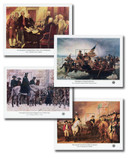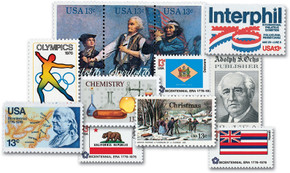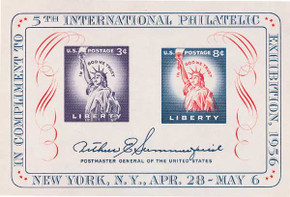
U.S. #1686-89
1976 American Bicentennial
Issue Date: May 29, 1976
City: Philadelphia, PA
Quantity: 1,990,000
Printed By: Bureau of Engraving and Printing
Printing Method: Lithographed
Perforations: 11
Color: Multicolored
On May 29, 1976, the Postal Service issued four souvenir sheets to commemorate INTERPHIL ‘76 (Seventh International Philatelic Exhibition) in Philadelphia, Pennsylvania. Each sheet contained five individually perforated stamps, which were valid for postage. Since the U.S. was celebrating its 200th anniversary of Independence, four famous Revolutionary War paintings were appropriately chosen as design subjects for the sheets.
The first sheet, which contained five 13-cent stamps, featured a reproduction of John Trumbull’s painting “The Surrender of Cornwallis at Yorktown.” Picturing the moment that “ended the war,” the scene shows American and French officers, including Washington, lined up to receive the British surrender.
A general in the British army, Cornwallis successfully led many troops into battle against the patriots. These victories made him a natural candidate to direct Britain’s campaign to capture the South in1780. Since Georgia and South Carolina had already been captured, Cornwallis began to move northward into North Carolina. After several losses, the British were forced to retreat to South Carolina, where they were crushed by patriot forces on January 17, 1781.
Eager to avenge the defeat, Cornwallis pursued the Continental Army to the southern border of Virginia. Against British commander-in-chief General Clinton’s wishes, he continued his march into Virginia and established his base at Yorktown. There, Washington surrounded him and began a siege operation which lasted for three weeks. Without supplies and with no hope for escape, Cornwallis surrendered on October 19, 1781, an action which ensured the American triumph.
Acting for Cornwallis, Brigadier General Charles O’Hara gave his sword to Major General Benjamin Lincoln. News of the surrender spread rapidly throughout the colonies. Reinforcements aboard a British fleet sailing to rescue Cornwallis turned back upon hearing the news. When word of the crushing defeat reached Prime Minister Lord North, he resigned his position, and the new British cabinet began peace negotiations with the United States. Occasional fighting, however, still continued in the South for more than a year. On September 3, 1783, the Treaty of Paris officially ended the war.
The Bicentennial Series
The U.S. Bicentennial was a series of celebrations during the mid-1970s that commemorated the historic events leading to America’s independence from Great Britain. The official events began on April 1, 1975, when the American Freedom Train departed Delaware to begin a 21-month, 25,338-mile tour of the 48 contiguous states. For more than a year, a wave of patriotism swept the nation as elaborate firework displays lit up skies across the U.S., an international fleet of tall-mast sailing ships gathered in New York City and Boston, and Queen Elizabeth made a state visit. The celebration culminated on July 4, 1976, with the 200th anniversary of the adoption of the Declaration of Independence.
The U.S.P.S. issued 113 commemorative stamps over a six-year period in honor of the U.S. bicentennial, beginning with the American Revolution Bicentennial Commission Emblem stamp (U.S. #1432). As a group, the Bicentennial Series chronicles one of our nation’s most important chapters, and remembers the events and patriots who made the U.S. a world model for liberty.
U.S. #1686-89
1976 American Bicentennial
Issue Date: May 29, 1976
City: Philadelphia, PA
Quantity: 1,990,000
Printed By: Bureau of Engraving and Printing
Printing Method: Lithographed
Perforations: 11
Color: Multicolored
On May 29, 1976, the Postal Service issued four souvenir sheets to commemorate INTERPHIL ‘76 (Seventh International Philatelic Exhibition) in Philadelphia, Pennsylvania. Each sheet contained five individually perforated stamps, which were valid for postage. Since the U.S. was celebrating its 200th anniversary of Independence, four famous Revolutionary War paintings were appropriately chosen as design subjects for the sheets.
The first sheet, which contained five 13-cent stamps, featured a reproduction of John Trumbull’s painting “The Surrender of Cornwallis at Yorktown.” Picturing the moment that “ended the war,” the scene shows American and French officers, including Washington, lined up to receive the British surrender.
A general in the British army, Cornwallis successfully led many troops into battle against the patriots. These victories made him a natural candidate to direct Britain’s campaign to capture the South in1780. Since Georgia and South Carolina had already been captured, Cornwallis began to move northward into North Carolina. After several losses, the British were forced to retreat to South Carolina, where they were crushed by patriot forces on January 17, 1781.
Eager to avenge the defeat, Cornwallis pursued the Continental Army to the southern border of Virginia. Against British commander-in-chief General Clinton’s wishes, he continued his march into Virginia and established his base at Yorktown. There, Washington surrounded him and began a siege operation which lasted for three weeks. Without supplies and with no hope for escape, Cornwallis surrendered on October 19, 1781, an action which ensured the American triumph.
Acting for Cornwallis, Brigadier General Charles O’Hara gave his sword to Major General Benjamin Lincoln. News of the surrender spread rapidly throughout the colonies. Reinforcements aboard a British fleet sailing to rescue Cornwallis turned back upon hearing the news. When word of the crushing defeat reached Prime Minister Lord North, he resigned his position, and the new British cabinet began peace negotiations with the United States. Occasional fighting, however, still continued in the South for more than a year. On September 3, 1783, the Treaty of Paris officially ended the war.
The Bicentennial Series
The U.S. Bicentennial was a series of celebrations during the mid-1970s that commemorated the historic events leading to America’s independence from Great Britain. The official events began on April 1, 1975, when the American Freedom Train departed Delaware to begin a 21-month, 25,338-mile tour of the 48 contiguous states. For more than a year, a wave of patriotism swept the nation as elaborate firework displays lit up skies across the U.S., an international fleet of tall-mast sailing ships gathered in New York City and Boston, and Queen Elizabeth made a state visit. The celebration culminated on July 4, 1976, with the 200th anniversary of the adoption of the Declaration of Independence.
The U.S.P.S. issued 113 commemorative stamps over a six-year period in honor of the U.S. bicentennial, beginning with the American Revolution Bicentennial Commission Emblem stamp (U.S. #1432). As a group, the Bicentennial Series chronicles one of our nation’s most important chapters, and remembers the events and patriots who made the U.S. a world model for liberty.













